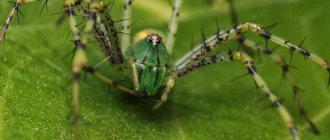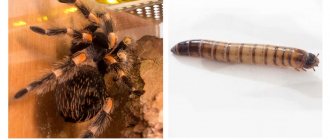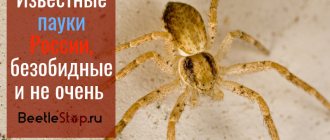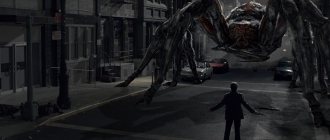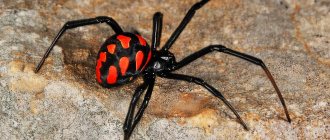Nature has endowed each dangerous spider with quite powerful poisonous fangs that paralyze the victim. The spider's venom is so strong that it can literally turn the victim's body tissue into slurry. There are about forty-two thousand species of spiders on Earth, but only a few pose a threat to human life. Due to its size, it is difficult for a spider to bite through human skin, but if it succeeds, it is unlikely to cause serious harm to health. However, there are a number of spiders that can kill a person. It is these species that we will talk about today. We recommend that you get acquainted with ten far from harmless, but even the most dangerous spiders in the world.
10. Wolf Spider
Tenth place goes to the wolf spider. If you don't tease him, he doesn't bother you. In case of a bite, a burning sensation and slight pain may occur, but it does not pose a danger to humans.
The wolf spider family is divided into more than a hundred genera and has almost 2.5 thousand species. They live all over the world, except Antarctica, although they prefer warm climates.
These spiders do not weave webs, but ambush their prey. For this and for their habit of hunting alone, they got their name. Their sizes are 10-35 mm. It is interesting that females bear offspring on their own - they carry a cocoon with spiderlings with them.
Tarantula
Tarantulas (lat. Lycosa) are a genus of poisonous and large (3.5 cm in length) araneomorphic spiders belonging to the family of wolf spiders (lat. Lycosidae). They live in almost all warm parts of the world. They are also long-lived spiders (lives more than 30 years).
flickr/andreafrassinetti
Tarantulas feed on insects, small amphibians, and can attack small rodents. It has a toxic poison that is fatal to many animals. However, people never died from its bite.
Brown Widow
The brown widow is a shy creature and tries to avoid conflicts, but if provoked, a bite is almost guaranteed. The poison is very strong, but she injects only part of it, and therefore the bite does not pose much danger. Usually a person feels a slight pain, and within 24 hours toxins are eliminated from the body.
This species is a “relative” of the well-known black widow; it can be recognized by the yellow or orange hourglass pattern on its abdomen and the black stripes on its legs.
Distributed in South America and the southern USA, Asia, Australia and southern Africa. Females are much larger than males and much more dangerous.
Australian record holder - giant crab spider
The honor of being called the largest arachnid on the Australian continent belongs to the giant crab spider. Its name is associated with the specific bending of the legs, characteristic of crabs (in some specimens their span sometimes reaches 30 centimeters). In another way, these spiders are called hunters, or huntsmen.
As a rule, the color of these creatures is black, brown or gray. The body is fluffy, and the spines are clearly visible on the legs. They live under the roots and on tree trunks, as well as in mountain crevices, between stones, and on the walls of houses. They feed mainly on insects, small lizards and frogs. These giant spiders are capable of chasing their prey along the ground at high speed before sinking their fangs into it and immobilizing it with venom.
Their toxin is moderately dangerous to humans. As a rule, painful swelling occurs at the site of the bite, sometimes accompanied by nausea and headache, but the poison does not pose a threat to human life.
Sydney leucopaweb (funnel web) spider
One of the few arthropods that can kill a person - its poison is very dangerous. As a result of the bite, blood pressure increases, profuse salivation and tears flow, muscle twitching, shortness of breath occurs, and without urgent medical attention, you can die from suffocation within half an hour.
Since 1981, when the antidote was invented, not a single person has died, but before that there were 13 deaths in the last century.
It is surprising that the poison selectively acts only on insects that the spider feeds on, primates and humans, but does not pose any danger to other animals. The Sydney leukoweb spider lives exclusively in eastern Australia. It is also called a funnel web because it weaves a web of an unusual cone shape.
Brown recluse spider
The degree of danger of this spider's venom depends on the size of the injected portion. The bite is almost insensitive, like a needle prick. But soon a wound appears in its place, which is covered with a black scab and can take up to three years to heal. There have been several reported deaths, mostly among children and the elderly. The brown recluse spider is native to the eastern and southern United States and northern Mexico.
It is not aggressive and bites only if it is carelessly disturbed.
But this probability is quite high due to the habit of this spider to settle in secluded corners of houses; it can even be found in bed. Outwardly, it is easy to confuse it with a harmless haymaker spider, so people usually do not see it as dangerous.
Northern leukopaweb spider
The venom of this spider is even stronger and more deadly than that of the Sydney leukoweb spider, its relative.
Cases of human bites are extremely rare due to the fact that its habitats are located far from human habitation - in the forests of eastern Australia, in trees.
Usually hides from the sun in secluded corners and is active at night. Grows up to eight centimeters.
Spider mouse
This predator lives in Australia and Chile. They called it that by mistake, believing that this spider, like a mouse, lives in burrows dug underground. The mouse spider is not too big - 1-3 cm. It hunts insects or other spiders. But he himself is prey for wasps, scorpions, bandicoots and labiopods. The mouse spider has a very dangerous protein toxin for humans. But, fortunately, he lives far from human habitation. In addition, like a cobra, it saves venom and prefers to bite “dry” when not hunting.
Redback Spider (Australian Widow Spider)
Releases a deadly nerve agent. As a result of the bite, you can die from suffocation. Thanks to this poison, it is considered the most dangerous in Australia. It is found everywhere on this continent, including in cities.
He likes to hide in dry, warm places, so you can stumble upon him, for example, in an outdoor toilet or wearing old clothes in which he is hiding.
This spider can be recognized by the red stripe on its back. The bite is very painful, severe pain spreads throughout the body. Since the invention of the antidote in the 50s of the last century, no deaths have been recorded.
The biggest spider on the planet runs damn fast
Until 2001, the goliath tarantula was considered the largest spider in the world. But in 2001, in the jungles of Laos, scientists discovered an even larger species, called the “giant huntsman spider.” Its length exceeds 30 centimeters! In addition to its size, it is known for its incredible speed: thanks to its long legs, it runs much faster than ordinary spiders. He is not overly aggressive, but if he decides that you are attacking him, he will not run away, but instead will move towards you (running!) or jump from the ceiling onto your shoulders. Most likely, the impressions received from such an attack will haunt you for the rest of your life.
Six-eyed sand spider
The six-eyed sand spider has a unique, not yet sufficiently studied venom, which destroys the walls of blood vessels, resulting in slow death from blood loss.
Two fatal cases were recorded.
These spiders live in South American and African deserts. They burrow into the sand and attack the victim from there. Fortunately, they rarely meet people.
The most terrible spiders
Each species of spider is scary in its own way, but this one can make you freeze in horror with its method of caring for its offspring. The fact is that the females of these creatures lay eggs and carry them on their backs for a long time, attaching them with a web. Not scary yet? Then see what the female looks like after hatching her babies.
Sometimes there are so many children that the spider’s body is completely covered with them - only the eyes remain visible. Dozens of tiny spiders ride on their mother's back until they learn to forage for food on their own. Imagine seeing such a spectacle at home - it was precisely for such occasions that Elon Musk probably started selling flamethrowers.
Chilean recluse spider
It is considered the most dangerous among recluse spiders. As a result of the action of its poison, skin and subcutaneous tissue cells die.
The bite causes severe pain and burning, like a burn, and is fatal in ten cases out of a hundred.
The rest of those bitten have to treat necrosis for many months. These spiders themselves do not attack humans and usually bite when accidentally caught under clothing. Distributed throughout South America. There are sizes up to 4 cm.
The spider is poisonous to humans. The most poisonous and dangerous spiders in the world Top 10. Photos of where they live
The first spiders (lat. Araneae) appeared on our planet about 400 million years ago, and they descended from a crab-like ancestor. Today there are more than 40 thousand species of spiders. I would like to immediately note that spiders do not belong to insects, but form a separate class and a separate order - arachnids (lat. Arachnida).
Spiders are found almost everywhere; many species even live in water. They have eight legs and eight eyes (rarely 2 or 6), and in front there are special limbs (with poisonous claws) called chelicerae. Having caught the victim, the spiders immediately inject it with their poison, and then inject a special saliva that liquefies the internal tissues of the insect, after which they simply suck out its insides, similar to soup.
Spiders are predators, feeding primarily on insects or small animals. An exception is the jumping spider, or Kipling's bagheera (lat. Bagheera kiplingi). It lives in Central America, where it feeds on formations on the leaves of acacia trees. Interestingly, all spiders are poisonous, but only some representatives of this class are truly dangerous to humans.
Brazilian spider soldier
Brazilian soldier spiders (lat. Phoneutria) are fast, very active and, most importantly, poisonous animals. It is also called the armed or banana spider. It got its name due to the fact that it does not spin webs like most of its fellows, because it does not need it, as it prefers a nomadic lifestyle. He loves to enter human habitation, where he can hide in shoes, clothes or dishes.
He lives in South America. He hunts insects, other spiders and even birds, and loves to feast on bananas. The 10-centimeter predator has a toxic venom that can kill a child or weakened adult before help can be provided. The poison of some specimens can be so dangerous that a person can die in 20-30 minutes.
Brown recluse spider
The brown recluse spider (lat. Loxosceles reclusa) is a species of araneomorphic spider from the family Sicariidae. Lives in the eastern USA. This arthropod has a poison that is very dangerous to human life, causing loxoscelism (necrosis of the skin and subcutaneous tissue). Gets along well next to people.
It can weave random nets in bundles or armfuls of firewood, in barns, basements, garages, attics and other convenient places. They often penetrate into human habitation, where they hide in shoe boxes, in clothes, underwear, behind skirting boards or paintings - in short, in those places that correspond to the natural habitats of this spider - burrows, crevices, tree bark.
Sydney leucopaweb or funnel web spider
The Sydney leukoweb or funnel web spider (lat. Atrax robustus) is a spider from the family Hexathelidae, the only one of the genus Atrax. Representative of the Australian continent. The funnel web spider is one of the few species of spiders that can cause serious harm to human health, and sometimes even kill him.
One bite from this spider is enough to kill a child. Death usually occurs within 15 minutes. The poison contains toxins that primarily affect the human nervous system. It is interesting that the venom of this spider is dangerous only for humans and primates, while it has no effect on other mammals.
Black Widow (Karakurt)
Probably the most famous venomous spider in the world. Its poison is quite dangerous. However, a not entirely substantiated legend has been created in art and the media, thanks to which many are convinced that a black widow’s bite leads to inevitable death.
There are 13 known fatal cases among children and the elderly in the United States in the 20th century, but most people escape with discomfort and pain at the site of the bite.
The black widow's habitat is the United States, southern Canada and northern Mexico. A distinctive feature of the species is a red pattern on a black glossy belly. Males of this species are much smaller than females and are quite harmless. Female black widows eat males after mating, which is how they get their name.
Karakurt
This spider is another representative of the black widow genus. Their distribution area is very vast; they can be found on all continents except Antarctica and the Arctic. Although the size of the karakurt is small - only 2-3 cm, it poses a mortal danger to humans. But only females are poisonous, and they attack only if they feel their life is threatened.
Bright red spots on the black body distinguish this spider from its relatives, but with age it can completely turn black. Karakurts settle mainly in dry places: on abandoned arable lands, near ravines. Sometimes they can visit people, crawling into houses, barns, garages and so on.
The bite of this species of black widows itself is not painful. But after a short time, when the poison begins to act, a person experiences severe poisoning. The place of the bite, and then the whole body, is pierced by a sharp pain, panic appears, it becomes difficult to breathe, and so on. A person is not in danger of instant death, but there is no need to delay in providing assistance.
Brazilian wandering spider
In 2010, the Brazilian spider was listed in the Guinness Book of Records as the most dangerous on the planet. Its venom has a neurotoxic effect on the body, the bite is incredibly painful and leads to failure of the muscles, lungs and heart, death occurs from suffocation.
This is one of the largest spiders - up to 15 cm. It lives in the South American tropics and is also called banana for its habit of hiding in banana leaves.
During the day it hides in cracks and other inconspicuous places, and at night it “wanders” in search of prey. Sensing danger, he takes a stance and begins to attack, while never retreating. He likes to climb into houses, bags, clothes, and often people become victims of his bites through negligence.
Phalanx Spider
It lives in arid regions of the planet: deserts and semi-deserts, steppes. Scientists call it the salpuga, bihork or camel spider. It is light brown in color, its limbs and body are covered with hairs. The camel spider is quite large, growing up to 7 cm in length.
Photo: u-teti-soni.blogspot.com: UGC
An active predator hunts at night. Termites, small beetles, and ants become food for it. It also attacks lizards and young rodents.
Phalanx is a spider that has an instant reaction due to the special structure of its eyes. He reacts with lightning speed to an approaching object and is an excellent hunter. When he sees light, he quickly hides in a dark place.
A camel spider bite is dangerous to humans. Rotting food remains on his jaw cause tissue inflammation. The chelicerae are so strong and sharp that they can bite through a human fingernail.




